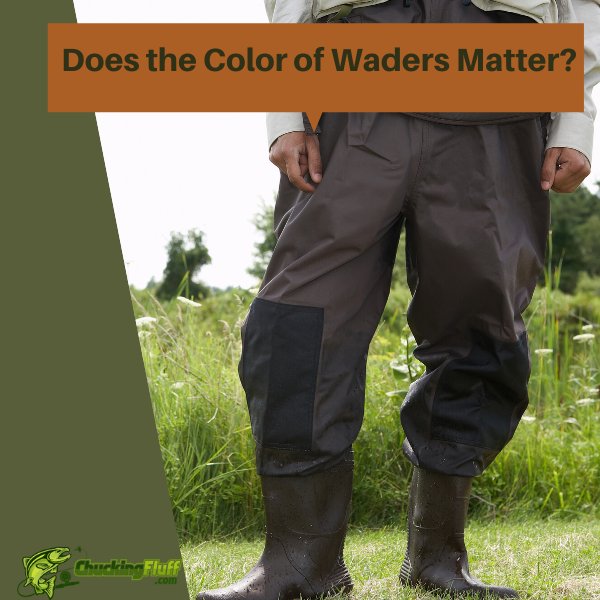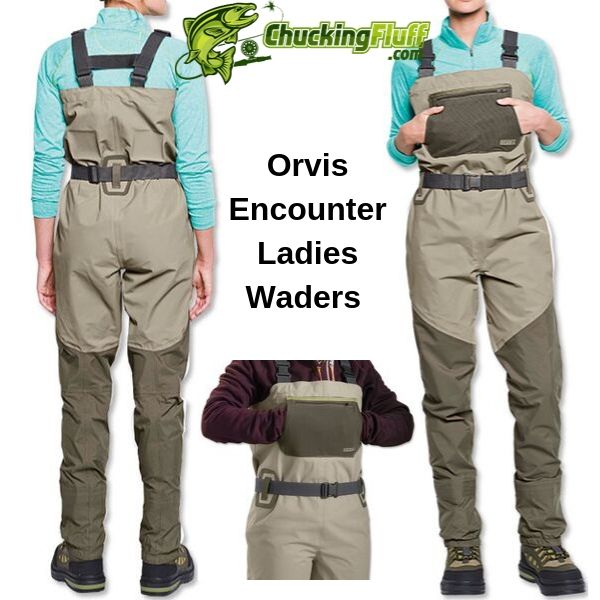| Disclosure: Just to be open and honest the buttons and links you click on in the website will in most cases take you to another website where you can purchase the products I am reviewing. As an Amazon Associate I earn from qualifying purchases. |
Does the Color of Waders Matter? Don’t Spook the Fish

Wader manufacturing has remained the same over the years.
We aren’t seeing fancy colors like the ever-changing street fashion and Gen Z’s bubbly taste – there could be a reason behind the earthy colors across all producers.
Anyway, does the color of waders matter?
Sure! Wader colors matter to all fish – including your beloved trout known for its highly developed vision.
Most fish perceive and track their food by color, contrast, and motion (we’ll leave the two out of this discussion).
Color discernment is part of the elements in a fish’s vision.
Briefly from my biology notes: The eye of most fish detects four light spectrums – blue, green, red and ultraviolet.
In some species like trout, ultraviolet fades when they hunt for two years.
Before you think about why manufacturers aren’t designing brighter waders, it is crucial to know that light has different behaviors in water unlike the air.
Quick Post Navigation
Does the Color of Waders Matter?
The color of waders matters a great deal.
Here’s the dilemma – you are fishing in an area with fewer anglers, and worse is if all of you are distances apart from each other.
Having a wader color that can make you visible in case you dunk in the water and need help is crucial.
But if you are out to catch spooky trout on skinny waters, earthly tones are recommended.
The secret is having a hi-vis belt for preparedness.
Best Wader Colors for Fly Fishing
Neoprene fishing waders are available in dark brown-greenish colors with some manufacturers designing them in camouflage, blue and green.
However, most anglers prefer breathable waders that come in shadow, slate, clay, 2/3-tone gray, tan, boulder, striker, olive, and storm colors.
Different manufacturers have different color names to waders they manufacturer, thus it is essential to check the available offerings and choose the best that suits your environment and cleaning needs.
One thing fervent fly fishers never compromise is the quality of their gear and equipment.
If brighter colors were the best for the sport, you would see all fly men and women in vibrant purple and green Barney suits but we’ll leave that for color parties.
Wader Colors for Picky Trout
If you’ve heard about trout fly fishing in Argentina’s Filo Hua Hum, you can agree that the preparedness level needs to be top-tier because trout here are pickier than those in most locations worldwide.
Anglers chasing these species need all advantages to get at least one fish and dressing counts.
Picky trout have seen the fairest share of anglers and flies and the best way to hook one or more is by being undetectable.
Your fashion sense will be crucial from the start, as you need to wear waders and jackets that blend in with the environment – better for you if you don’t announce your presence.
Because if you do, you are as well out to tone your arms without hooking a thing.
The river camo pattern isn’t new in the fly-angling department.
Manufacturers design these to give fly fishers cover from trout and picky species, even in areas without real cover.
Others will be available in muted shades of brown and green Gore-Tex for more help with blinding these buddies.
Wader Colors for Night Fishing
Does the color of waders matter when fly fishing in the dark?
It is dark and you are planning on adventuring on the waters for the first time.
You will probably be on the water alone or with a few diehards like yourself.
The situations will need you to be visible enough because you are no raider.
Stick to earthly colors for your waders but bring a hi-vis belt or strip to stick on the upper back of your waders.
You will be having a fishing headlamp, glow in the dark fly lines, and safety glasses which are enough illumination.
Let this not be a sign for you to come out in your Bottega Veneta green to scare life out of those you need to catch.
FAQs on Wader Colors
Though a controversial topic, here are more insights in Q N A that should help you get the right color of waders.
Q) Do Kayaking and Waterfowl Waders in Earthly Colors Work for Fishing?
A) It depends on the color and print on them.
Most waterfowl hunting waders won’t work well to give you enough cover from fish because of their dense prints.
Most kayaking waders on the other hand resemble those on fishing waders but their construction might be different.
Thus, you will note a difference in the fit and storage.
Q) Are Women’s Fishing Waders Available in Brighter Colors?
A) Forget the fancy-looking waders being sold on online commercial stores – those aren’t meant for the female angler.
Manufacturers like Caddis are now advancing to teal waders for women and the reception is great so far.
However, the teal is quite toned to avoid spooking fish.
Otherwise most wader manufacturers like Simms, Patagonia, and Redington are designing them in the same colors as males’ but with a more feminine fit and cut.
Q) Which Is the Best Wader Color for Small Water Fishing?
A) Go drab when fishing in small waters, especially if they are highly frequented by anglers.
Fish here are more cautious that you think and earth tones will do.
Dark waders and a tan vest isn’t a bad combo.
The shirt sleeves can be dark green or any other muted tone.
You want to ensure you aren’t giving fish in such waters another reason to be weary.
Conclusion
So, does the color of waders matter?
It does! Your wardrobe sense matters.
I know fluorescent colors are important, especially if you are casting in dangerous waters, are a novice at angling and swimming, or are in areas with few fly fishers; but there is a way of adding visibility to your gear without going all out.
Think about your fishing location, check the weather to know what else to pack and in what colors, and think about the time you will be casting.
The position of the sun is vital because some species are more sharp-eyed and strange reflections will make them bolt the opposite direction.
Consider all these variables!


